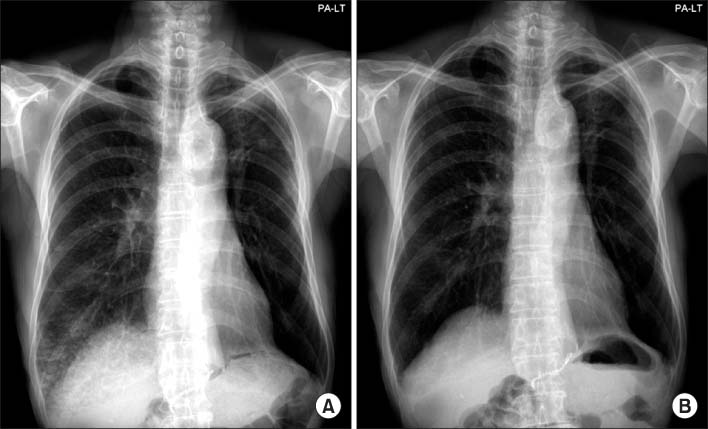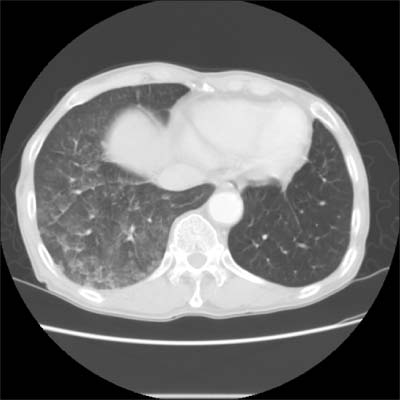Tuberc Respir Dis.
2010 Jun;68(6):354-357. 10.4046/trd.2010.68.6.354.
A Case of Lipid Pneumonia by Green Perilla Oil
- Affiliations
-
- 1Department of Internal Medicine, Kangwon National University School of Medicine, Chuncheon, Korea. ssunimd@kangwon.ac.kr
- KMID: 1458045
- DOI: http://doi.org/10.4046/trd.2010.68.6.354
Abstract
- Exogenous lipid pneumonia is a rare disease resulting from the aspiration or inhalation of vegetable, animal, or mineral oils. In Korea, the most frequently implicated agent is squalen, which can be obtained from shark liver oil. Lipid pneumonia by aspiration of the vegetable oil is very rare. We experienced a 77-year-old man with a history of ingestion of green perilla oil. His clinical course was favorable; after exposure to the oil was stopped, the patient's symptoms improved.
MeSH Terms
Figure
Reference
-
1. Spickard A 3rd, Hirschmann JV. Exogenous lipoid pneumonia. Arch Intern Med. 1994. 154:686–692.2. Gondouin A, Manzoni P, Ranfaing E, Brun J, Cadranel J, Sadoun D, et al. Exogenous lipid pneumonia: a retrospective multicentre study of 44 cases in France. Eur Respir J. 1996. 9:1463–1469.3. Choi HS, Kwag HJ, Chae SW, Lim SY, Lim SY. Severe exogenous lipoid pneumonia following ingestion of large dose squalene: successful treatment with steroid. Tuberc Respir Dis. 2006. 60:235–238.4. Hyun JG, Rhee CH. Clinical investigation of lipoid pneumonia in adults. Tuberc Respir Dis. 1996. 43:965–975.5. Lee JS, Ju HD, Lee GL, Han CW, Cho YS, Park US, et al. A case of lipoid pneumonia induced by aspiration of shark liver oil. Tuberc Respir Dis. 1994. 41:670–675.6. Jeong KJ, Kim YE, Lim GJ, Suh KD, Kim JD, Lee JH, et al. A case of lipoid pneumonia after ingestion of green perilla oil. Tuberc Respir Dis. 1999. 47:123–126.7. Park JC, Jung CY, Lee JK, Lee YJ, Park SC, Seo HJ, et al. A case of exogenous lipoid pneumonia after ingestion of squalene in patients with achalasia. Tuberc Respir Dis. 2008. 65:421–425.8. Sundberg RH, Kirschner KE, Brown MJ. Evaluation of lipoid pneumonia. Dis Chest. 1959. 36:594–601.9. Wright BA, Jeffrey PH. Lipoid pneumonia. Semin Respir Infect. 1990. 5:314–321.10. Rossi SE, Erasmus JJ, Volpacchio M, Franquet T, Castiglioni T, McAdams HP. "Crazy-paving" pattern at thin-section CT of the lungs: radiologic-pathologic overview. Radiographics. 2003. 23:1509–1519.11. de Albuquerque Filho AP. Exogenous lipoid pneumonia: importance of clinical history to the diagnosis. J Bras Pneumol. 2006. 32:596–598.12. Simmons A, Rouf E, Whittle J. Not your typical pneumonia: a case of exogenous lipoid pneumonia. J Gen Intern Med. 2007. 22:1613–1616.13. Felson B, Ralaisomay G. Carcinoma of the lung complicating lipoid pneumonia. AJR Am J Roentgenol. 1983. 141:901–907.14. Spatafora M, Bellia V, Ferrara G, Genova G. Diagnosis of a case of lipoid pneumonia by bronchoalveolar lavage. Respiration. 1987. 52:154–156.15. Scully RE, Galdabini JJ, McNeely BU. Case records of the Massachusetts General Hospital: weekly clinicopathological exercises. Case 22: 1977. N Engl J Med. 1977. 296:1279–1287.
- Full Text Links
- Actions
-
Cited
- CITED
-
- Close
- Share
- Similar articles
-
- A Case of Lipoid Pneumonia after Ingestion of Green Perilla Oil
- Anti-atherosclerotic effects of perilla oil in rabbits fed a high-cholesterol diet
- The Effect of Grape Seed Oil, Perilla Oil, or Corn Oil-Containing Diet on Lipid Patterns in Rats and Fatty-Acid Composition in Their Liver Tissues
- A Case of Lipoid Pneumonia Induced by Aspiration of Shark Liver Oil
- Effects of perilla oil on plasma concentrations of cardioprotective (n-3) fatty acids and lipid profiles in mice




